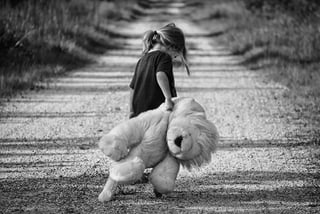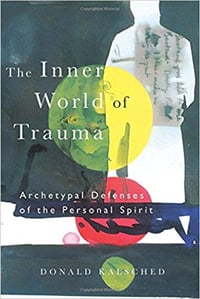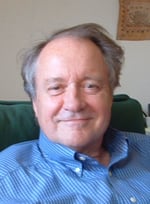Trauma and the Soul: Psychoanalytic Approaches to the Inner World An Interview with Jungian Analyst Donald Kalsched
A Guest Blog Post by Bonnie Bright, Ph.D.
 Trauma is an injury to the capacity to feel, says Jungian analyst Donald Kalsched, who has specialized in the field of trauma for decades. He describes trauma as something that occurs when we are given more to experience than we can consciously bear, especially if we lack resources to help metabolize the feelings that emerge. For example, a child in an emotionally illiterate family who has no place to turn for support may be traumatized by certain events.
Trauma is an injury to the capacity to feel, says Jungian analyst Donald Kalsched, who has specialized in the field of trauma for decades. He describes trauma as something that occurs when we are given more to experience than we can consciously bear, especially if we lack resources to help metabolize the feelings that emerge. For example, a child in an emotionally illiterate family who has no place to turn for support may be traumatized by certain events.
“Trauma survivors have faced such unbearable feelings that they've had to dissociate,” notes Kalsched. “That's something the psyche does to protect us, and it protects something sacred and imperishable about the human spirit by dissociating that part of us into the inner world and protecting it there with defenses.”
Kalsched, who is a speaker and is presenting at the post-conference workshop on trauma at “Trauma + Transcendence: Depth Psychology, Spirituality and the Sacred,” a conference at Pacifica Graduate Institute in June 2018, also led a certificate program for clinicians, “Trauma, Dissociation, and the Soul,” in November 2017[1]. On the topic of wounding to the feeling capacity, he references psychoanalyst, Paul Russell[2] , who said, "All psychopathology that comes to us for help, for mending, is really the scar tissue of the injury to the capacity to feel."
 In the 1980s, Kalsched started witnessing that the dream material of people who had been abused or neglected was often very persecutory. In their dreams, these individuals were harassed, criticized, and tyrannized by dark (often masculine) figures. Kalsched became interested in those figures, because many of them seemed to have a transpersonal dimension, which, in Jungian language, might be described as archetypal or daemonic, he notes. They appear to be hybrid beings, part human and part archetypal, from the collective layer of the unconscious.
In the 1980s, Kalsched started witnessing that the dream material of people who had been abused or neglected was often very persecutory. In their dreams, these individuals were harassed, criticized, and tyrannized by dark (often masculine) figures. Kalsched became interested in those figures, because many of them seemed to have a transpersonal dimension, which, in Jungian language, might be described as archetypal or daemonic, he notes. They appear to be hybrid beings, part human and part archetypal, from the collective layer of the unconscious.
Through them, Kalsched began to perceive a system of defense he termed the “self-care system,” which is made up of both protective and persecutory inner objects. They are difficult to work with in clinical situations because they have such power in the inner world of the trauma survivor, he maintains, often arising as great sources of resistance to the healing process one might expect in psychotherapy.
One of the most common ways we experience these negative tyrannical figures in the unconscious is through shame. They often attack the self-esteem of the patient and drive him or her into a “dark sense of their own inadequacy, their own defectiveness, their own inferiority.”
However, the figures are not mere interjections of the critical parent or authority figures in one’s life; rather, they have tremendous archetypal powers, Kalsched insists. While Jung offered some rather profound ideas on the archetypal dimension of the human psyche, he didn't often talk about archetypal defenses. These inner figures tend to attack the ego of the patient and fill the dream with terror and anxiety and self-loathing to the point where the dreamer feels totally disillusioned and may even wake up disassociated, he notes, offering a compelling example from his psychotherapy practice in New York in which a woman experienced a memory of trauma from a very young age, and was ultimately persecuted by a menacing figure in her nighttime dreams in spite of being open to hope and healing at the time she recalled the event.
 Kalsched, who trained in Jungian psychoanalysis at the Jung Center in New York in the ‘60s and ‘70s, was a deep advocate of the psyche's integrative tendencies for healing and wholeness. However, he is keenly aware that when a child experiences something unbearable, he is open to dissociation. These menacing figures are a personification of the dissociative defenses, he suggests, in the sense that they will not let certain feelings associated with catastrophe be experienced again. The figures must be educated and transformed in the process of the therapeutic work because they are a defense against feeling what was overwhelming.
Kalsched, who trained in Jungian psychoanalysis at the Jung Center in New York in the ‘60s and ‘70s, was a deep advocate of the psyche's integrative tendencies for healing and wholeness. However, he is keenly aware that when a child experiences something unbearable, he is open to dissociation. These menacing figures are a personification of the dissociative defenses, he suggests, in the sense that they will not let certain feelings associated with catastrophe be experienced again. The figures must be educated and transformed in the process of the therapeutic work because they are a defense against feeling what was overwhelming.
While the psyche is inherently wise, Kalsched explains, some of its wisdom is in the interest of the patient's survival, not in the interest of wholeness at that particular time. It may be a matter of surviving in pieces in order for the deeper integration that needs to happen to occur much later. If the “inner tyrant,” as Kalsched referred to it when we spoke, relaxes his agitation and his violence and becomes more trusting in the process, then an individual can start to see some of genuine transformative experiences of healing and wholeness.
 In his book, “The Inner World of Trauma,” Kalsched traces the discoveries of others on the topic. Ronald Fairbairn (1889-1964), a Scottish psychiatrist, psychoanalyst and a central figure in the development of the object relations theory of psychoanalysis, calls a figure like this the “internal saboteur.” British psychoanalyst Wilfred Bion (1897-1979) referred to the “sadistic superego.” Contemporary psychoanalyst Neville Symington labels it the “internal tyrant.” Still others call it the “critic.” Richard Schwartz, whose internal family systems theory has made an impact in trauma literature and in the healing of trauma, calls this figure a “manager,” Kalsched reports, noting that Schwartz discovered a new way of working with that inner figure which is very useful, as is Jung's process of active imagination. First, one must see the tyrannical figure, must find some way to make it visible, he insists. When a person comes into therapy, they don't see the defense because they're identified with it. It’s only once it comes to light that one can come into relationship with it.
In his book, “The Inner World of Trauma,” Kalsched traces the discoveries of others on the topic. Ronald Fairbairn (1889-1964), a Scottish psychiatrist, psychoanalyst and a central figure in the development of the object relations theory of psychoanalysis, calls a figure like this the “internal saboteur.” British psychoanalyst Wilfred Bion (1897-1979) referred to the “sadistic superego.” Contemporary psychoanalyst Neville Symington labels it the “internal tyrant.” Still others call it the “critic.” Richard Schwartz, whose internal family systems theory has made an impact in trauma literature and in the healing of trauma, calls this figure a “manager,” Kalsched reports, noting that Schwartz discovered a new way of working with that inner figure which is very useful, as is Jung's process of active imagination. First, one must see the tyrannical figure, must find some way to make it visible, he insists. When a person comes into therapy, they don't see the defense because they're identified with it. It’s only once it comes to light that one can come into relationship with it.
Trauma survivors almost always have trouble expressing anger effectively, and many of them get caught in an angry cycle called the “victim-perpetrators cycle,” Kalsched points out. Every child who is abused or traumatized may experience rage and anger at the person that's abusing him, but that anger is almost never able to be expressed because to express the anger towards the abusing figure may generate a lot more trouble for the child. In these circumstances, the child internalizes the anger and takes up the position of the aggressor against him or herself. Thus, the tyrannical figure turns out to be the ingrown anger that should have been available for self-expression, but which got turned back on the self. There are at least two different scenarios at play when it comes to trauma. Jung’s psychology deals largely with neurotic psychology, wherein certain experiences have been conscious at some point in point our lives but were then rejected, leaving us with unsavory or unacceptable parts of ourselves that we repress. These rejected parts make up the shadow personality and then they haunt us in our dreams.
Nightmares stemming from neurotic psychology might be terrifying at the beginning of the analytic process, because they are an effort to help us integrate some of the disowned material which can come back in angry forms. However, as we begin to relate to it in a different way through the psychotherapeutic process, it can become more integrated. With dissociative psychology, on the other hand, an experience that occurred early in life may have been so overwhelming for the immature ego that it has never been in consciousness and it tends to emerge in the form of archetypal images. Jung’s work is critical in this process, because his model of the psyche help us to understand that when things can't be represented personally, they get represented trans-personally. When they can't be registered symbolically and in language, they get registered in the body. To work with these very early archetypal affects and energies in the psyche, we have to pay attention to the body.
We are all more or less traumatized, Kalsched affirms, avowing that “Reality confronts us with things that break our hearts.” We can experience trauma merely by contemplating our own deaths. As a young girl, one of Kalsched’s patients was deeply affected when she saw a magazine article about the Holocaust, leading to anxiety attacks, sleeplessness, and, ultimately, treatment by a psychiatrist. The reality of man's inhumanity to man was unbearable for her, and she didn’t have an emotionally literate family to help her metabolize or integrate that experience.
We are also up against a huge traumatic reality at this time in history, Kalsched believes. If we truly allow ourselves to take in what we're doing to the Earth right now, it is heartbreaking. Instead, for many of us, we are experiencing a profound denial of what is happening in the world around us. This denial is part of the self-care system's efforts to prevent us from having to feel the devastating feelings that we need to have that would ultimately allow us to do something about the trauma we’re feeling.
We each live with a tremendous amount of loss and fear: fear of our own emotions, of intimacy with others, and of “otherness,” Kalsched acknowledges. There’s also a huge amount of unacknowledged terror in all of us about death, limitation, human limitation, the impermanence of life, what we're doing to ourselves, what we're doing to the planet. We desperately need emotionally literate and empathically-attuned containers with other people in which we can talk about the traumatic grief we experience, and to share it with other people. We need to form communities of like-minded people. We generally have trouble acknowledging the beautiful, vulnerable, fragility, and innocence of the human spirit, and sharing on that level with each other—sometimes because of our traumatic backgrounds and because of the culture. The culture does not promote this. Ultimately, being able to understand how trauma works on us can help us deal with it and give us impetus to find a resolution.
Finally, Kalsched addresses his interest in the mystical aspects of trauma. Many trauma survivors have been broken in ways that actually breaks them through into another dimension of the psyche. While there’s a dark figure in the self-care system Kalsched describes, there's also a “bright angel.” Some individuals have had miraculous life-saving encounters with beauty, often in nature, or sometimes even at the brink of death. Some have had experiences of angelic presences which have literally saved their lives.
In these scenarios, Jung once again adds so much to our understanding, Kalsched insists, because Jung believed there is a spiritual dimension to life, that we all have a religious instinct that senses and hungers for that connection to spirit. Because trauma is often about those broken places, those “cracked places in the crystal of life where we couldn't go on,” where we just couldn't survive without help. It’s these cracks where the light can come through.
There can be a danger in in seeking the world of spirit too strongly, because it can lead us to spiritual bypass of our own pain. Those numinous bright angels in the self-care system can be put in the service of defense against feeling just as much as the dark figures can, so and it’s not necessarily a long-term solution, but for the trauma survivor, it often is life-saving, especially when they're kids. In his second book, "Trauma and the Soul,” Kalsched attempts to capture some of those stories.
For Jung, wholeness means “something unique, something related to psycho-spiritual integration,” Kalsched writes. “Perhaps no other single notion is more central to Jung’s understanding of the human struggle than the idea of wholeness—our lifelong pursuit of it, and possibly its lifelong pursuit of us.”[3] Perhaps the best thing we can each do in the face of trauma is to let that wholeness pursue us, and to surrender in its wake.
Listen to the full audio interview with Donald Kalsched here (approx. 31 mins):
Get details or register for the conference “Trauma+Transcendence: Depth Psychology, Spirituality and the Sacred" at Pacifica June 2018
[1] Donald Kalsched led a program for clinicians at Pacifica Graduate Institute, “Trauma, Dissociation, and the Soul,” November 2017
[2] Learn more about the work of Paul Russell in a book review, Trauma, Repetition, and Affect Regulation: The work of Paul Russell can be found here -->
[3] In Trauma and the Soul: A Psycho-Spiritual Approach to Human Development and Its Interruption, by Donald Kalsched. New York: Routledge, p. 166.
 Donald Kalsched, Ph.D., is a Jungian psychoanalyst and clinical psychologist. He is a senior faculty member and supervisor with the Inter-Regional Society of Jungian Analysts, and teaches and leads workshops nationally and internationally. His celebrated book, The Inner World of Trauma: Archetypal Defenses of the Personal Spirit, explores the interface between contemporary psychoanalytic theory and Jungian theory as it relates to clinical work with survivors of early childhood trauma. His recent book, Trauma and the Soul: A Psycho-Spiritual Approach to Human Development and its Interruption, explores the mystical dimensions of clinical work with trauma-survivors.
Donald Kalsched, Ph.D., is a Jungian psychoanalyst and clinical psychologist. He is a senior faculty member and supervisor with the Inter-Regional Society of Jungian Analysts, and teaches and leads workshops nationally and internationally. His celebrated book, The Inner World of Trauma: Archetypal Defenses of the Personal Spirit, explores the interface between contemporary psychoanalytic theory and Jungian theory as it relates to clinical work with survivors of early childhood trauma. His recent book, Trauma and the Soul: A Psycho-Spiritual Approach to Human Development and its Interruption, explores the mystical dimensions of clinical work with trauma-survivors.
 Bonnie Bright, Ph.D., is a graduate of Pacifica’s Depth Psychology program, and the founder of Depth Psychology Alliance, a free online community for everyone interested in depth psychologies. She also founded DepthList.com, a free-to-search database of Jungian and depth psychology-oriented practitioners, and she is the creator and executive editor of Depth Insights, a semi-annual scholarly journal. Bonnie regularly produces audio and video interviews on depth psychological topics. She has completed 2-year certifications in Archetypal Pattern Analysis via the Assisi Institute and in Technologies of the Sacred with West African elder Malidoma Somé, and she has trained extensively in Holotropic Breathwork™ and the Enneagram.
Bonnie Bright, Ph.D., is a graduate of Pacifica’s Depth Psychology program, and the founder of Depth Psychology Alliance, a free online community for everyone interested in depth psychologies. She also founded DepthList.com, a free-to-search database of Jungian and depth psychology-oriented practitioners, and she is the creator and executive editor of Depth Insights, a semi-annual scholarly journal. Bonnie regularly produces audio and video interviews on depth psychological topics. She has completed 2-year certifications in Archetypal Pattern Analysis via the Assisi Institute and in Technologies of the Sacred with West African elder Malidoma Somé, and she has trained extensively in Holotropic Breathwork™ and the Enneagram.



